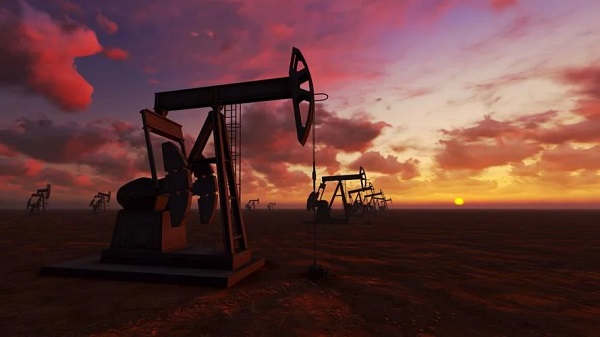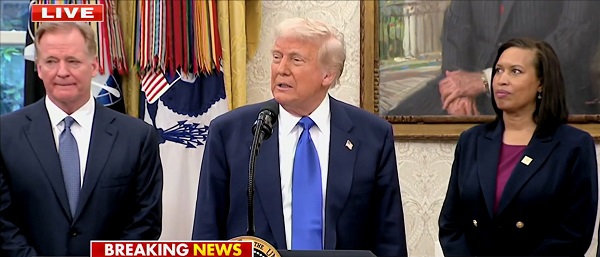Energy
Trump vows to reduce energy costs with his latest cabinet picks

From The Center Square
By Casey Harper
“With U.S. Energy Dominance, we will drive down Inflation, win the A.l. arms race with China (and others), and expand American Diplomatic Power to end Wars all across the World.”
With his latest cabinet nominations, President-elect Donald Trump promised to bring down the cost Americans pay for energy by expanding oil and gas production.
Trump named North Dakota Gov. Doug Burgum as secretary of the Interior as well as chairman of “the newly formed, and very important, National Energy Council.”
“As Chairman of the National Energy Council, Doug will have a seat on the National Security Council,” Trump said in a statement. “As Secretary of the Interior, Doug will be a key leader in ushering in a new ‘Golden Age of American Prosperity’ and World Peace. ‘
“We will ’DRILL BABY DRILL,’ expand ALL forms of Energy production to grow our Economy, and create good-paying jobs,” he added. “By smartly utilizing our amazing National Assets, we will preserve and protect our most beautiful places, AND reduce our deficits and our debt!”
Trump said the new energy council will involve all parts of the federal government dealing with energy.
“This Council will oversee the path to U.S. ENERGY DOMINANCE by cutting red tape, enhancing private sector investments across all sectors of the Economy, and by focusing on INNOVATION over longstanding, but totally unnecessary, regulation,” Trump said. “With U.S. Energy Dominance, we will drive down Inflation, win the A.l. arms race with China (and others), and expand American Diplomatic Power to end Wars all across the World.”
As part of his Burgum pick and his nomination of fracking entrepreneur Chris Wright to lead the Department of Energy, Trump promised to get energy prices down.
“We will also undo the damage done by the Democrats to our Nation’s Electrical Grid, by dramatically increasing baseload power,” Trump said.
Trump also named William Owen Scharf as assistant to the President and White House Staff Secretary.
So far, Trump has pointed to the loyalty of his choices, saying how they endorsed him or helped him win reelection when announcing them as his choices.
“Will is a highly skilled attorney who will be a crucial part of my White House team. He has played a key role in defeating the Election Interference and Lawfare waged against me, including by winning the Historic Immunity Decision in the Supreme Court.”
Trump followed his electoral win with a flurry of cabinet picks, some expected and some that are sure to stir things up.
In particular, Trump’s picks of Robert F Kennedy Jr to lead the Department of Health and Human services, veteran and Fox News host Pete Hegseth to lead the Secretary of Defense, and former Congressman Matt Gaetz to lead the Department of Justice have sparked headlines.
More picks are on the way as Trump has to fill out positions across the federal government.
Whether Trump can get the Senate to confirm his nominees, especially the more controversial picks, remains to be seen.
Trump’s list of nominees so far include:
- North Dakota Gov. Doug Burgum as Secretary of the Interior.
- William Owen Scharf as Assistant to the President and White House Staff Secretary.
- Robert F. Kennedy Jr. as head of U.S. Health and Human Services
- Former Congresswoman and veteran Tulsi Gabbard as Director of National Intelligence.
- Former Congressman Doug Collins as Secretary of Veterans Affairs
- Jay Clayton as Chairman of the U.S. Securities and Exchange Commission.
- Former congressman Matt Gaetz for Attorney General.
- Veteran and Fox News host Pete Hegseth as Secretary of Defense.
- Veteran and former New York congressman Lee Zeldin as head of the Environmental Protection Agency.
- U.S. Sen. Marco Rubio, R-Fla., as Secretary of State.
- Former Immigration and Customs Enforcement Director Tom Homan as “border czar.”
- Former Director of National Intelligence John Ratcliffe as Director of the Central Intelligence Agency.
- Former Congresswoman and current governor of South Dakota, Kristi Noem as Secretary of the Department of Homeland Security.
- Elon Musk and Vivek Ramaswamy to lead the “Department of Government Efficiency.
- William Joseph McGinley as White House Counsel.
- Steven C. Witkoff as Special Envoy to the Middle East.
- Rep. Mike Waltz, R-Fla. as national security advisor.
- Former Arkansas Gov. Mike Huckabee as ambassador to Israel.
- Rep. Elise Stefanik, R-N.Y. as ambassador to the U.N.
- Dean John Sauer as Solicitor General.
- Todd Blanche as Deputy Attorney General.
- Emil Bove as Principal Associate Deputy Attorney General.
- Dan Scavino of the Trump campaign as Assistant to the President and Deputy Chief of Staff.
- Susie Wiles, co-chair of the Trump campaign, as White House Chief of Staff.
- Stephen Miller as Assistant to the President and Deputy Chief of Staff for Policy and Homeland Security Advisor.
- James Blair of the Trump campaign as Assistant to the President and Deputy Chief of Staff for Legislative, Political and Public Affairs.
- Taylor Budowich of the Trump campaign as Assistant to the President and Deputy Chief of Staff for Communications and Personnel.
Casey Harper
D.C. Bureau Reporter
Automotive
Federal government should swiftly axe foolish EV mandate

From the Fraser Institute
Two recent events exemplify the fundamental irrationality that is Canada’s electric vehicle (EV) policy.
First, the Carney government re-committed to Justin Trudeau’s EV transition mandate that by 2035 all (that’s 100 per cent) of new car sales in Canada consist of “zero emission vehicles” including battery EVs, plug-in hybrid EVs and fuel-cell powered vehicles (which are virtually non-existent in today’s market). This policy has been a foolish idea since inception. The mass of car-buyers in Canada showed little desire to buy them in 2022, when the government announced the plan, and they still don’t want them.
Second, President Trump’s “Big Beautiful” budget bill has slashed taxpayer subsidies for buying new and used EVs, ended federal support for EV charging stations, and limited the ability of states to use fuel standards to force EVs onto the sales lot. Of course, Canada should not craft policy to simply match U.S. policy, but in light of policy changes south of the border Canadian policymakers would be wise to give their own EV policies a rethink.
And in this case, a rethink—that is, scrapping Ottawa’s mandate—would only benefit most Canadians. Indeed, most Canadians disapprove of the mandate; most do not want to buy EVs; most can’t afford to buy EVs (which are more expensive than traditional internal combustion vehicles and more expensive to insure and repair); and if they do manage to swing the cost of an EV, most will likely find it difficult to find public charging stations.
Also, consider this. Globally, the mining sector likely lacks the ability to keep up with the supply of metals needed to produce EVs and satisfy government mandates like we have in Canada, potentially further driving up production costs and ultimately sticker prices.
Finally, if you’re worried about losing the climate and environmental benefits of an EV transition, you should, well, not worry that much. The benefits of vehicle electrification for climate/environmental risk reduction have been oversold. In some circumstances EVs can help reduce GHG emissions—in others, they can make them worse. It depends on the fuel used to generate electricity used to charge them. And EVs have environmental negatives of their own—their fancy tires cause a lot of fine particulate pollution, one of the more harmful types of air pollution that can affect our health. And when they burst into flames (which they do with disturbing regularity) they spew toxic metals and plastics into the air with abandon.
So, to sum up in point form. Prime Minister Carney’s government has re-upped its commitment to the Trudeau-era 2035 EV mandate even while Canadians have shown for years that most don’t want to buy them. EVs don’t provide meaningful environmental benefits. They represent the worst of public policy (picking winning or losing technologies in mass markets). They are unjust (tax-robbing people who can’t afford them to subsidize those who can). And taxpayer-funded “investments” in EVs and EV-battery technology will likely be wasted in light of the diminishing U.S. market for Canadian EV tech.
If ever there was a policy so justifiably axed on its failed merits, it’s Ottawa’s EV mandate. Hopefully, the pragmatists we’ve heard much about since Carney’s election victory will acknowledge EV reality.
Daily Caller
Trump Issues Order To End Green Energy Gravy Train, Cites National Security


From the Daily Caller News Foundation
By Audrey Streb
President Donald Trump issued an executive order calling for the end of green energy subsidies by strengthening provisions in the One Big Beautiful Bill Act on Monday night, citing national security concerns and unnecessary costs to taxpayers.
The order argues that a heavy reliance on green energy subsidies compromise the reliability of the power grid and undermines energy independence. Trump called for the U.S. to “rapidly eliminate” federal green energy subsidies and to “build upon and strengthen” the repeal of wind and solar tax credits remaining in the reconciliation law in the order, directing the Treasury Department to enforce the phase-out of tax credits.
“For too long, the Federal Government has forced American taxpayers to subsidize expensive and unreliable energy sources like wind and solar,” the order states. “Reliance on so-called ‘green’ subsidies threatens national security by making the United States dependent on supply chains controlled by foreign adversaries.”
Dear Readers:
As a nonprofit, we are dependent on the generosity of our readers.
Please consider making a small donation of any amount here.
Thank you!
Former President Joe Biden established massive green energy subsidies under his signature 2022 Inflation Reduction Act (IRA), which did not receive a single Republican vote.
The reconciliation package did not immediately terminate Biden-era federal subsidies for green energy technology, phasing them out over time instead, though some policy experts argued that drawn-out timelines could lead to an indefinite continuation of subsidies. Trump’s executive order alludes to potential loopholes in the bill, calling for a review by Secretary of the Treasury Scott Bessent to ensure that green energy projects that have a “beginning of construction” tax credit deadline are not “circumvented.”
Additionally, the executive order directs the U.S. to end taxpayer support for green energy supply chains that are controlled by foreign adversaries, alluding to China’s supply chain dominance for solar and wind. Trump also specifically highlighted costs to taxpayers, market distortions and environmental impacts of subsidized green energy development in explaining the policy.
Ahead of the reconciliation bill becoming law, Trump told Republicans that “we’ve got all the cards, and we are going to use them.” Several House Republicans noted that the president said he would use executive authority to enhance the bill and strictly enforce phase-outs, which helped persuade some conservatives to back the bill.
-

 Crime2 days ago
Crime2 days ago“This is a total fucking disaster”
-

 Fraser Institute1 day ago
Fraser Institute1 day agoBefore Trudeau average annual immigration was 617,800. Under Trudeau number skyrocketted to 1.4 million annually
-

 International2 days ago
International2 days agoChicago suburb purchases childhood home of Pope Leo XIV
-

 MAiD2 days ago
MAiD2 days agoCanada’s euthanasia regime is already killing the disabled. It’s about to get worse
-

 Daily Caller2 days ago
Daily Caller2 days ago‘I Know How These People Operate’: Fmr CIA Officer Calls BS On FBI’s New Epstein Intel
-

 Daily Caller2 days ago
Daily Caller2 days agoBlackouts Coming If America Continues With Biden-Era Green Frenzy, Trump Admin Warns
-

 Red Deer2 days ago
Red Deer2 days agoJoin SPARC in spreading kindness by July 14th
-

 Business1 day ago
Business1 day agoPrime minister can make good on campaign promise by reforming Canada Health Act






